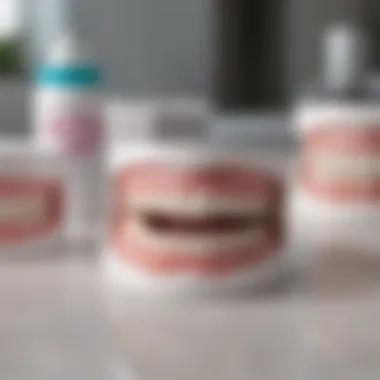Brilliant White Teeth Whitening: Methods & Benefits


Intro
Achieving brilliant white teeth is often regarded as a hallmark of good dental hygiene and overall health. The desire for a radiant smile goes beyond aesthetics; it embodies confidence and can influence personal and professional interactions. With numerous methods available today, from professional treatments to natural alternatives, it is crucial to understand the science, benefits, and potential risks involved in teeth whitening solutions.
This article aims to uncover the multifaceted world of teeth whitening, delineating methods, discussing their effectiveness, and evaluating their impact on long-term dental health. By exploring these various avenues, readers will be equipped with the necessary insights to make informed decisions about their whitening journeys.
Key Benefits
Physical Health Benefits
Whitening one's teeth can lead to physical health advantages beyond mere appearance. For starters, some whitening procedures, particularly professional treatments, include comprehensive dental check-ups that can uncover underlying issues such as cavities or gum disease. These professional cleanings not only whiten teeth but also promote overall dental health.
Additionally, certain at-home whitening products, when used responsibly, contain ingredients that can help in the removal of surface stains, thereby improving oral hygiene. Over time, this enlightenment may encourage individuals to adopt better oral care habits, resulting in healthier teeth and gums.
Mental Well-being Enhancements
The link between physical appearance and mental health is well-documented. A brighter smile can enhance self-esteem and foster positive interactions. People often report feeling more confident after undergoing whitening treatments. When they are satisfied with their smiles, they are more likely to engage socially and professionally, affecting their overall well-being. The psychological benefits associated with having a visually appealing smile cannot be understated. The act of smiling itself triggers positive emotional responses, benefiting both the individual and those around them.
"A confident smile opens doors that may have otherwise been closed."
Practical Tips
Choosing the Right Method
When diving into teeth whitening, it is essential to select an appropriate method. Here’s a brief overview:
- Professional Treatments: These are conducted by dental professionals. They typically yield the fastest and most noticeable results.
- Over-the-Counter Products: Options like whitening strips or gels provide a more affordable alternative. They require consistent use to see results and may not be as effective as professional treatments.
- Natural Remedies: Some individuals turn to options like baking soda or hydrogen peroxide. While they may provide mild whitening effects, it is important to approach these methods with caution.
Maintaining Results
After investing in whitening treatments, preserving the results is equally important.
- Regular Brushing and Flossing: This is foundational to maintaining oral hygiene and can help inhibit new stains from forming.
- Dietary Adjustments: Consumption of stain-causing foods and drinks should be moderated. Substituting dark-colored beverages with water or using a straw can help minimize staining.
Prologue to Teeth Whitening
Teeth whitening is a significant topic for those who seek to enhance their dental aesthetics. It goes beyond mere vanity; rather, it encompasses self-confidence and overall well-being. This discussion will delve into the methods, benefits, and various considerations related to achieving brilliant white teeth.
Improved dental aesthetics can lead to enhanced self-image and social interactions. Bright, white teeth are often associated with good health and attractiveness. As such, individuals are increasingly exploring teeth whitening options. There is an array of methods available, each presenting unique benefits and limitations. Understanding these can help individuals make informed decisions based on personal needs and preferences.
Furthermore, exploring the field of teeth whitening reveals insights into both professional services and home-based solutions. For health professionals, wellness coaches, and others, recognizing the latest trends in teeth whitening can illuminate helpful resources for clients looking to enhance their smiles. Maintaining the value of a bright smile in personal and professional contexts cannot be overlooked.
Understanding the Importance of Dental Aesthetics
Dental aesthetics play a crucial role in how individuals perceive themselves and others. A clean, white smile often conveys a sense of hygiene, commitment, and self-care. Many studies indicate the positive effects of a good smile on social perception. People with bright smiles are frequently viewed as friendly and confident. Given these societal perceptions, the pursuit of teeth whitening becomes a common endeavor.
Moreover, dental aesthetics can influence personal health. Those who feel embarrassed about their teeth may avoid smiling. This could lead to social isolation and, ultimately, a detrimental impact on mental health. Therefore, improving one's smile can serve as a pathway to increased social interaction and a better quality of life.
Importance of Brilliant White Teeth in Society
In contemporary society, bright white teeth are often seen as a status symbol. The cultural emphasis on appearance has established a connection between personal and professional success with well-maintained teeth. For many individuals, a radiant smile can enhance job prospects and even relationship opportunities.
This societal pressure drives the demand for effective teeth whitening solutions. Many people seek quick fixes through various products available in the market. However, it is essential to weigh these choices critically. Exploring the underlying motivations for teeth whitening can demonstrate how societal norms shape individual decisions concerning beauty and health.
"A bright smile is more than just teeth; it's an expression of confidence."
The Chemistry of Teeth Whitening
Teeth whitening is not merely a cosmetic endeavor; it requires a sound understanding of the chemical processes involved. Knowing the chemistry behind these methods empowers users to make informed decisions about their dental care. Teething problems regarding stains can be tackled more effectively if one grasps the interactions between various whitening agents and dental structures. In this section, we delve into how chemical compounds interact with tooth enamel, the role of active ingredients in whitening products, and what this means for the efficacy and safety of these methods.


How Whitening Agents Work
Whitening agents primarily target the pigments that create discoloration in teeth. These agents typically contain substances like hydrogen peroxide or carbamide peroxide, which are known for their bleaching properties. When applied to the surface of the teeth, these agents penetrate the enamel and dentin layers.
Once in place, the agents break down the stained compounds into smaller, less colored particles. This process is known as oxidation. Notably, the effectiveness of the whitening agents depends on their concentration and exposure time.
It's important to consider:
- Concentration Matters: Higher concentrations may lead to quicker results but also increase the likelihood of adverse effects such as tooth sensitivity or gum irritation.
- Exposure Time: Longer exposure can enhance whitening but can also risk damaging enamel if not monitored correctly.
Understanding these points allows users to select suitable products or treatments for their own dental needs.
Role of Hydrogen Peroxide in Whitening
Hydrogen peroxide is often considered the backbone of many professional and over-the-counter whitening products. Its powerful oxidative properties enable it to break down pigmented molecules effectively. When applied, hydrogen peroxide alters the chemical structure of these stains, transforming them into less pigmented varieties.
The benefits of hydrogen peroxide in teeth whitening include:
- It acts quickly, producing visible results
- It interacts with both enamel and dentin, allowing for deeper penetration of stains
However, it is crucial to approach hydrogen peroxide with caution. While effective, improper use can potentially lead to:
- Increased tooth sensitivity
- Damage to gum tissue if not carefully applied
"Understanding the chemical mechanisms of teeth whitening is crucial for making informed choices about products and treatments."
With a grounded comprehension of the chemistry of teeth whitening, individuals can better navigate the various options available, ultimately leading to healthier and brighter smiles.
Professional Teeth Whitening Treatments
Professional teeth whitening treatments offer a range of benefits that can significantly enhance one’s smile. These procedures are carried out under the supervision of dental professionals, ensuring not only effective results but also safety during the application. As dental aesthetics gain importance in society, many are looking towards professional solutions that promise to deliver whiter teeth without jeopardizing oral health.
One can find two main types of professional whitening treatments: in-office procedures and custom take-home kits. Each has unique attributes that cater to different preferences and needs. Understanding these options can help individuals make informed decisions regarding their dental care. Moreover, professional treatments are designed to address deeper stains, making them more effective than many over-the-counter products.
In-Office Whitening Procedures
In-office whitening procedures are popular for their swift results. These treatments are typically performed using a high concentration whitening agent, such as hydrogen peroxide, combined with light or laser exposure. The procedure generally takes about an hour, and results can be dramatic, often lightening teeth by several shades in a single session. However, it's important to consider that individual results may vary based on initial tooth color and other factors.
Some advantages of in-office whitening include:
- Immediate Results: Visible improvements after just one visit.
- Professional Supervision: Dental professionals ensure the process adheres to safety protocols.
- Customized Treatment: Dentists tailor the procedure based on specific dental conditions.
It is also crucial to talk with the dental provider about their specific techniques and products used as these can influence the overall success of treatment.
Custom Take-Home Whitening Kits
Custom take-home whitening kits represent a more flexible option for those seeking teeth whitening. Dental professionals create personalized trays that fit snugly over one's teeth, which allows for even distribution of the whitening gel. Patients typically use these kits over several weeks, gradually achieving their desired level of whiteness.
Benefits of this option include:
- Convenience and Flexibility: Patients use the kit at their own pace and schedule.
- Tailored Fit: Custom trays improve contact with the whitening agent, leading to more effective results.
- Less Sensitivity: Many find that these kits result in less irritation than in-office treatments.
However, it’s essential to follow use instructions closely to avoid overuse, which could lead to sensitivity or uneven results.
Safety and Efficacy of Professional Treatments
Concerns regarding the safety and efficacy of teeth whitening are very valid. It is essential to use products that are clinically tested and recommended by dental professionals. Professional treatments are designed with safety in mind, and supervision helps mitigate risks associated with improper application.
Some key points regarding their safety and efficacy include:


- Controlled Environment: Procedures are conducted in offices equipped with necessary tools and know-how.
- Minimal Risk: Unlike many DIY treatments, there are protocols to safeguard against adverse effects.
- Proven Results: Many studies document the effectiveness of professional treatments when performed by dentists.
Ultimately, engaging with professional teeth whitening treatments can be an effective method to achieve that desired smile, provided that one is vigilant about the choices made.
"Consulting a dental professional can provide insight into the most suitable whitening option for your unique dental situation."
Over-the-Counter Whitening Products
Over-the-counter (OTC) whitening products are a significant topic in the discussion of achieving brilliant white teeth. These products offer an accessible and affordable alternative to professional treatments. Many people prefer OTC options due to convenience and the ability to use them at home. Understanding the types of available products and their effectiveness is crucial for individuals seeking to enhance their smiles safely.
Whitening Strips
Whitening strips are one of the most popular OTC dental whitening products. They typically contain a low concentration of hydrogen peroxide, which is effective in brightening teeth. Users place the strips on their teeth for a specified period, usually 30 minutes to an hour each day. Most brands recommend usage for several days to achieve visible results. The convenience of whitening strips makes them attractive to many. They are easy to apply and can be done in the comfort of one’s home. However, results can vary based on the initial shade of one's teeth and adherence to instructions. Care should be taken to avoid overuse, as this can lead to enamel sensitivity.
Whitening Toothpaste
Whitening toothpaste is another OTC option widely available. These toothpastes often contain mild abrasives that help remove surface stains. Some formulas include chemical agents that assist in breaking down stains, further enhancing their effect. While they can help brighten teeth, the results are generally subtle compared to those obtained with strips or professional treatments. It is important to note that whitening toothpastes are used daily and will not significantly change the natural color of teeth. They are best for maintaining whiteness after more intensive treatments and can also provide standard oral hygiene benefits. Users should look for products that have the American Dental Association (ADA) Seal of Acceptance, ensuring safety and effectiveness.
Whitening Mouthwashes and Rinses
Whitening mouthwashes and rinses serve as an adjunct to regular oral hygiene. Many consumers incorporate these products into their daily routines with the expectation of achieving whiter teeth. The key ingredients in some whitening mouthwashes can include hydrogen peroxide or carbamide peroxide. These ingredients help in breaking down stains and reducing plaque buildup. However, the efficacy of these rinses is often debated. They may contribute to a fresher breath and improved overall oral hygiene but are unlikely to provide dramatic changes in teeth color. Users should not rely solely on mouthwashes for whitening. Instead, they should consider them as part of a broader hygiene and whitening strategy.
Comparative Effectiveness of OTC Products
When evaluating the effectiveness of OTC whitening products, various factors must be taken into account. Each product category offers different benefits and outcomes:
- Whitening strips often lead to more noticeable results due to higher active ingredient concentrations. They are suited for individuals with moderate staining.
- Whitening toothpaste usually provides minimal whitening effects. They benefit those who wish to improve surface stain removal while maintaining oral care routines.
- Whitening rinses, while convenient, generally require continued use for extended periods to see any results. Their primary role is supporting overall oral hygiene rather than being a primary whitening agent.
Choosing the right product often comes down to individual needs, current teeth shade, and sensitivity levels. Users should remain realistic about expectations and try a combination of these products for the best results.
"The best approach for dazzling white teeth may involve a mix of professional treatment and diligent home care."
Every option within the OTC whitening space has its place in enhancing dental aesthetics. However, proper use and understanding of each can significantly influence overall outcomes.
Natural Teeth Whitening Remedies
Exploring natural teeth whitening remedies serves a dual purpose—providing alternatives to chemical whitening agents and emphasizing the necessity of mindful dental care. As society increasingly becomes aware of ingredients and their long-term effects, many individuals are turning to natural options. These remedies, such as baking soda, activated charcoal, and hydrogen peroxide, offer various benefits while presenting specific considerations.
Baking Soda and Its Abrasive Properties
Baking soda is often cited as a popular teeth whitening remedy. It is a mild abrasive that can help remove surface stains from teeth. Its effectiveness lies in its ability to exfoliate the enamel, thereby brightening the smile. Additionally, baking soda possesses alkaline properties, which can neutralize acids produced by bacteria in the mouth. This may contribute to better overall oral health.
When using baking soda for whitening, it is vital to employ it cautiously. Excessive scrubbing can lead to enamel wear, which may increase sensitivity and make teeth more susceptible to decay. A common recommendation is to mix baking soda with a small quantity of water to form a paste, applying it gently with a toothbrush for limited periods.
Activated Charcoal
Activated charcoal has gained attention as a natural teeth whitening method. Its porous nature allows it to adsorb toxins and impurities, helping to eliminate surface stains. Some users appreciate its ability to offer an alternative to traditional whitening products that contain chemicals.
However, the evidence supporting the efficacy of activated charcoal for teeth whitening remains largely anecdotal. Moreover, its abrasive texture could potentially damage enamel when used regularly. Users should exercise caution and limit their use, opting for occasional applications rather than daily routines.
Hydrogen Peroxide Solutions
Hydrogen peroxide is another natural whitening agent that can enhance the brightness of teeth. It essentially breaks down stains and lightens their color. Many over-the-counter whitening products contain hydrogen peroxide as a primary ingredient, often in higher concentrations.
For at-home use, consumers should dilute hydrogen peroxide with water to minimize irritation and sensitivity. A common ratio is one part hydrogen peroxide mixed with two parts water. Swishing this solution in the mouth for a short time can yield visible improvements in tooth color. Nonetheless, people with sensitive gums should remain attentive, as hydrogen peroxide can cause discomfort.
Limitations of Natural Remedies
While natural remedies offer appealing benefits, it is important to recognize their limitations. The effectiveness of these methods is often modest compared to professional treatments. Additionally, reliance on natural agents may foster complacency regarding overall dental hygiene. It is crucial to understand that these remedies should complement, rather than replace, regular dental care practices.


Moreover, the long-term safety of frequent use of certain natural whitening agents, such as activated charcoal and baking soda, is still subject to debate. Potential enamel erosion risks highlight the need for a balanced approach that combines natural whitening techniques with professional guidance.
"Natural remedies can be a starting point, but they should not overshadow the importance of a regular dental routine."
Risks and Considerations of Teeth Whitening
Teeth whitening is often viewed as an appealing route to enhance one’s smile. However, this excitement can overshadow the critical discussion about the risks and considerations associated with various whitening methods. Understanding these aspects is essential not only for safety but also for achieving long-term dental health. Dental professionals urge potential users to weigh the advantages against potential downsides to make informed and wise choices.
Possible Sensitivity and Irritation
One of the most common side effects associated with teeth whitening is sensitivity. Many users report heightened sensitivity to hot and cold temperatures after treatment. This occurs as whitening agents, such as hydrogen peroxide, penetrate the enamel and irritate the underlying nerves. Common factors that contribute to sensitivity include the concentration of the whitening agent, duration of exposure, and the frequency of use.
Increased sensitivity typically subsides after a short period, but for some, it can persist longer. Considerations for individuals with existing sensitive teeth are vital. Those interested in whitening should engage a dental professional for tailored solutions that minimize discomfort. Sometimes, using desensitizing toothpaste before and after treatment can reduce these effects.
Impact on Enamel Integrity
Teeth whitening treatments can affect the structural integrity of enamel. Enamel serves as a protective layer for the teeth, and excessive use of strong whitening agents may lead to enamel erosion. This erosion can expose the dentin and make teeth more susceptible to decay.
Dental experts highlight the importance of moderation. The long-term use of strong whitening products can compromise enamel health. They recommend consulting with a dentist to assess individual risk factors before starting any whitening regimen. Regular dental check-ups are also critical for monitoring enamel health over time.
Oral Health and Preexisting Conditions
Before embarking on a teeth whitening journey, it is crucial to consider preexisting oral health conditions. Individuals with cavities, gum disease, or other dental issues may experience complications from whitening treatments. Using whitening products can aggravate these underlying problems, leading to more severe issues down the road.
Dental professionals often advise treating any oral health problems before considering whitening. Being transparent about one’s dental history during consultations can help identify the safest options.
"Whitening procedures should never replace proper dental care; they complement it."
Maintaining Teeth Whiteness
Maintaining the whiteness of teeth is crucial for achieving and preserving a radiant smile. It encompasses various practices that extend beyond the initial whitening treatments. With the right approach, individuals can enjoy the aesthetic benefits of bright teeth for an extended period. This section discusses the significance of ongoing maintenance and practical strategies for achieving lasting results.
Dietary Considerations
Diet plays a significant role in the maintenance of teeth whiteness. Certain foods and beverages can stain teeth or promote discoloration over time. For instance, drinks like coffee, tea, and red wine are known to leave stains due to their intense pigments. Additionally, dark-colored fruits, such as blueberries or blackberries, can contribute to a dull appearance if consumed excessively.
To promote lasting whiteness, consider the following dietary adjustments:
- Stay Hydrated: Drink plenty of water throughout the day. It helps rinse away food particles and reduce the risk of staining.
- Opt for Whitening Foods: Some foods can naturally help whiten teeth. These include crunchy fruits and vegetables, such as apples, celery, and carrots, which can act as natural abrasives, removing surface stains as you chew.
- Dairy Products: Milk, cheese, and yogurt can help neutralize acids in the mouth. Calcium and phosphates in these foods support enamel health, which is crucial for maintaining a luminous smile.
Hygiene Practices for Lasting Results
Oral hygiene is vital for maintaining the effects of whitening treatments. Establishing a thorough routine can significantly impact the color and health of your teeth. Here are key practices to consider:
- Regular Brushing: Brush your teeth at least twice a day for two minutes each time. Use a fluoride toothpaste designed for whitening while avoiding abrasive formulas that might damage enamel.
- Floss Daily: Flossing removes plaque and food debris between teeth, preventing stains from forming in hard-to-reach areas. This habit is vital for overall oral health.
- Use Mouthwash: Consider incorporating a non-abrasive whitening mouthwash that helps remove surface stains and freshens breath. Always choose one without alcohol to avoid drying out the mouth and irritating gums.
- Routine Dental Check-Ups: Regular visits to the dentist help monitor teeth condition and conduct professional cleanings. Your dental professional may offer touch-up treatments or guidance specific to your whitening maintenance.
"Regular oral hygiene practices not only enhance the aesthetics of your smile but also contribute to long-term dental health."
Epilogue
The conclusion of this article underlines the significance of understanding teeth whitening. With a variety of options available, from professional treatments to natural remedies, informed choices are crucial for those seeking a brighter smile. The methods discussed throughout this text highlight the importance of balancing effectiveness with safety while being aware of potential risks associated with each approach.
Making Informed Choices
In deciding on a whitening method, consumers need to consider various factors. Professional treatments like those offered by Zoom or Opalescence tend to yield noticeable results quickly. However, they may require a larger financial commitment. Over-the-counter solutions such as Crest 3D White strips or Colgate Optic White toothpaste are used more conveniently at home but require consistent usage for best results. Natural remedies might present an economical alternative, but their efficacy can vary greatly.
Thus, individuals should reflect on their dental health, budget, and lifestyle when choosing a whitening strategy. Consulting with a dentist is also a good practice, as it ensures that the selected method aligns with personal needs while minimizing any adverse side effects, such as sensitivity or enamel damage.
Future Trends in Teeth Whitening
Looking ahead, trends in teeth whitening are evolving with technological advances. Products that incorporate personalized treatments, using impressions and AI, are emerging. These innovations could make teeth whitening not just more effective but also safer by tailoring treatments to individual dental conditions.
Furthermore, there is growing interest in sustainable and natural alternatives. As consumers become more health-conscious, brands may introduce more environmentally friendly products. In addition, research into the microbiome may yield insights into maintaining oral health while achieving whitening goals, thereby enhancing the overall safety and effectiveness of treatment options that prioritize gum and enamel health.
The future holds promising avenues for those seeking brilliant white teeth, emphasizing a balance between aesthetic desires and health considerations.













